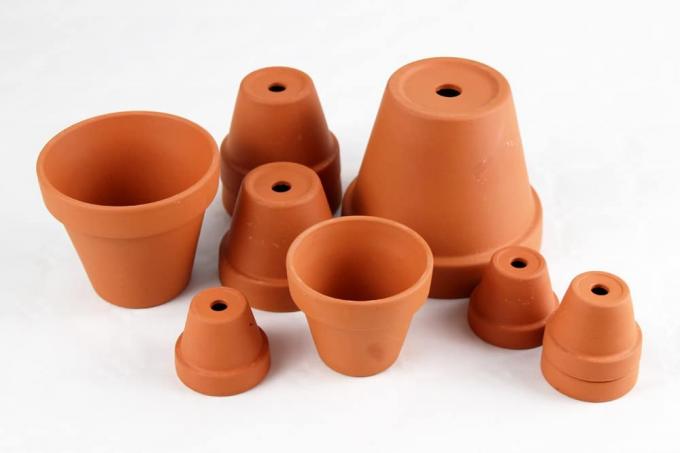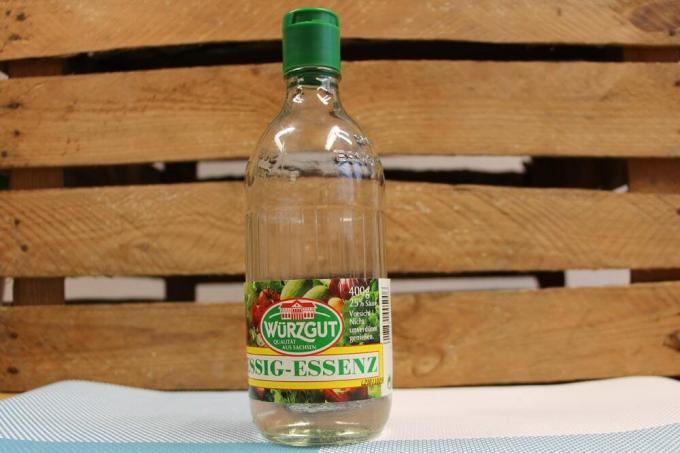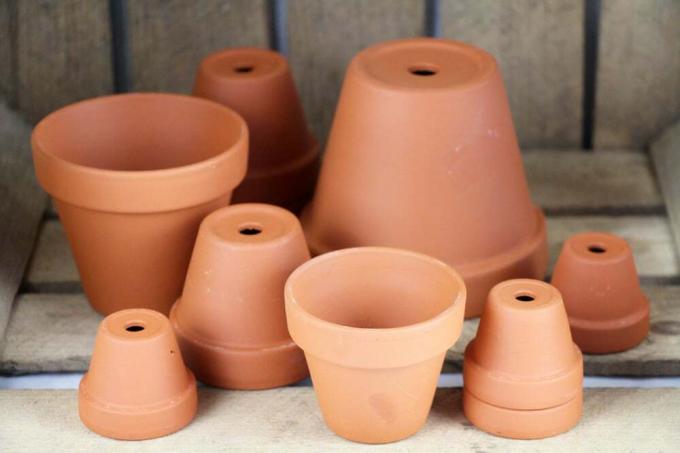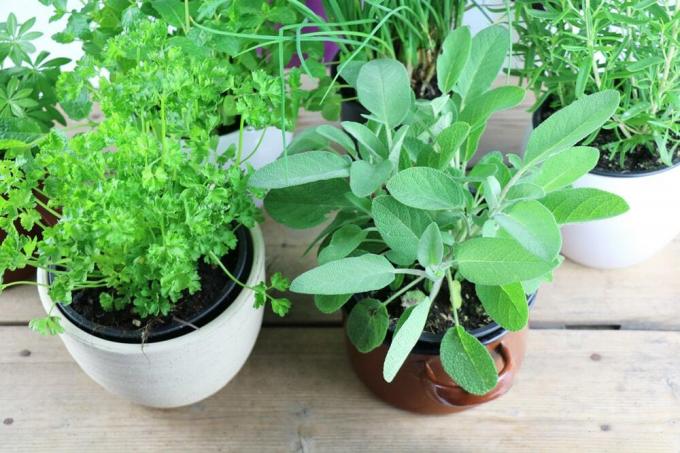

Table of contents
- What distinguishes terracotta?
- How do unwanted deposits form?
- Remove limescale and verdigris - this is how it works
- preparatory work
- Tips for prevention – farewell to patina
The well-groomed appearance of terracotta pots is limited by external influences. If unsightly limescale and a green patina form, this vintage look is not to everyone's taste. After treatment with simple home remedies, your valuable clay pots will look like they have been peeled from the egg. This guide explains how to properly clean your flower pots. Benefit from these tips for the best care and cleaning.
What distinguishes terracotta?
Terracotta flower pots are very popular with creative gardeners. Planters made of plastic, stone or concrete cannot match their authentic, Mediterranean flair. In addition, the special production from clay scores with a special advantage for the growth and vitality of the plants settled in it. The German name is derived from the Italian "terra cotta" and literally means "burnt earth".
In fact, terracotta pots are fired from clay at temperatures of up to 1,000 degrees Celsius over a period of around 24 hours. This process extracts the water from the pores so that the material hardens. A subsequent water bath of 2 to 3 hours not only cools the vessels down, but also creates reliable weather and frost resistance. Nevertheless, the material remains slightly porous and therefore air-permeable. Therefore, the root balls of plants in terracotta pots do not wither as quickly as in flower pots made of plastic or glazed ceramic, even in the blazing sun of the summer.
In publications you can read again and again that organic acid residues in terracotta have a negative impact on plant growth. In fact, the lowering of the pH value in the substrate is hardly measurable. Furthermore, the already minimal accumulation of acid is washed out with the irrigation water through the porous pot wall.
How do unwanted deposits form?
A whitish or green patina will already develop on new terracotta pots in the first garden and balcony season. We have summarized the most common causes below:
- Hard watering leaves limescale residue in the pores
- Water that spills over evaporates on the outer walls and deposits lime residues
- Accumulated minerals and plant debris act as a breeding ground for moss and algae
Verdigris primarily affects clay pots that are in semi-shady to shady and cool, damp locations. The combination of mineral breeding ground and low-light locations offers green spore plants ideal living conditions, as they are rootless plants and do not need soil.
Tip:
Flower pots made of high-quality, handcrafted Impruneta terracotta are characterized by guaranteed frost resistance and a long service life. However, the premium flower pots are not immune to unsightly white and green deposits.
Remove limescale and verdigris - this is how it works
You can do without expensive cleaning agents to remove deposits from your terracotta pots. In a well-stocked household, there are two agents that have proven to be effective for cleaning flower pots. We explain the correct application step by step below:
preparatory work
In the first step, remove the entire substrate from the flower pot. Scrape off stubborn root remains with the blunt side of a knife so that the clay material is not damaged. The coarse side of a scouring pad from the kitchen does a good job here. An initial rough cleaning with clear water that is as hot as possible increases the effect of the following cleaning agents.
vinegar water

Vinegar takes on both lime and verdigris. Thus, one agent is sufficient for effective cleaning without the use of chemicals. How to do it right:
- Mix vinegar with water in a ratio of 1: 4 (250 ml vinegar to 1 liter of water)
- If it is slightly dirty, spray the pot with the vinegar water and leave it to work for a few minutes
- Soak a heavily soiled terracotta pot in vinegar water for a few hours
If a flower pot is too big to soak in vinegar water, the dirt gradually gets to the bottom. Soak a cloth in the liquid and place it on the areas to be cleaned for a few hours. Continue until all affected areas are treated.
Limescale stains, moss and algae can then be easily removed with a soft to medium-strong brush. Finally, to remove the last vinegar residues from the pores, please rinse the clean flower pot thoroughly with clear water. Ideally, you should use collected rainwater or boiled tap water so that new limescale deposits do not immediately open the floodgates again.
Tip:
Home gardeners with their own pond place dirty terracotta pots in water for a few days so that they are completely covered. The deposits soften and can be removed with a brush. Alternatively, clay flower pots take a water bath for 3 to 7 days in the soft water of the rain barrel.
baking soda
Baking soda is a household name in every household. Less well known is the powerful effect on deposits that spoil a terracotta flower pot. How to use the home remedy for cleaning clay pots professionally:
- Heat the water slightly and stir in a teaspoon of baking soda per liter
- Put in the terracotta pot and soak for 2 to 3 hours
- Remove and scrub thoroughly with a brush
If the affected flower pot is only covered with limescale deposits, it is usually not necessary to clean it with a brush afterwards. Limescale dissolves completely by itself in baking soda water.
Tips for prevention – farewell to patina

You can effectively prevent unsightly deposits. You do not have to resort to expensive impregnation agents from specialist shops, as there is a home remedy available for this purpose. Simple linseed oil is perfectly sufficient to protect your new flower pots from limescale and verdigris. Apply the all-natural oil to the inside and outside immediately after purchase, before the vessel comes into contact with water or soil for the first time. Give terracotta pots this treatment every year and you won't have to bother with cleaning. In addition, you prevent deposits on clay vessels:
- Place in a sunny, warm and rain-protected location
- Avoid a seat on the weather side (in Europe the west side)
- Put pots on feet so that water can run off quickly
- Water plants primarily with filtered rainwater or well stale tap water
- When repotting meticulously remove all root and soil residue
- Clean out wilted flowers before the petals fall off and stick to the pot wall
 garden editorial
garden editorial I write about everything that interests me in my garden.
Learn more about garden decor

How to: Make patina yourself | Perfect rust look
Rust is actually a very unpopular phenomenon on tools, vehicles and in the garden, but patina has become a trend in recent years. We show how you can create the perfect rust look yourself.

Cladding the garden wall: 13 ideas for wall cladding
Lovingly designed flower beds are only half as beautiful when a gray concrete wall rises up in the background. Unfortunately, this cannot be removed so easily. No problem, because there are other ways to visually enhance the garden. This guide has many creative ideas for covering a garden wall.

Make signs for the herb garden yourself: Make herb signs
You can get signs for the most common herbs in stores, but home-made herb signs have much more charm and can be labeled individually. Thanks to meaningful labeling, mix-ups in your herb garden are now a thing of the past.

Plant zinc tub - suitable plants
A beautiful old zinc tub makes a very good decoration for the terrace or garden. In the past, these tubs were used in households to wash clothes or bathe small children.

These 3 software and 5 online garden planners are free?
On the way to the dream garden, virtual garden planning gives your wishes unlimited scope. You don't have to spend any money to visualize and skilfully plan your green paradise. These 3 software and 5 online garden planner are free.

Remove tree stump - burn out or mill?
If a tree was felled on a plot in front of a family house, the stump must disappear because he has most of the other planting plans on the already not huge property adversely affected.



